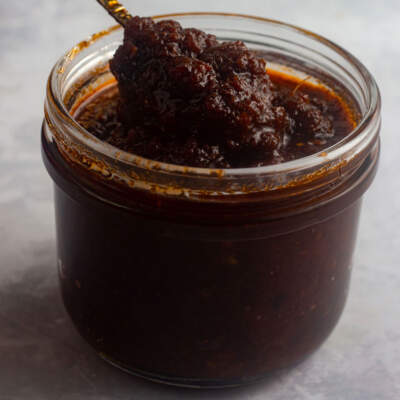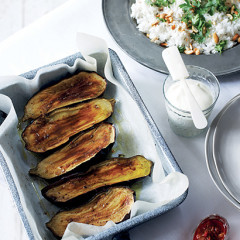Shito, a sumptuously hot chilli condiment ubiquitous in West African cuisine, is made with plenty of fresh shito chillies, Scotch bonnets, fresh tomato, finely crushed dried crustaceans and shrimp, vegetable oil, aromatics and black pepper. Recipes differ from family to family, and its colour ranges from a deep red to dark brown, almost black. Traditionally, the ingredients are ground together in an asanka, a grinder similar to a mortar and pestle, with an hourglass-shaped wooden “pestle” and textured clay bowl. The asanka is replaced by an electric food processor in most modern kitchens. There’s no one correct way to prepare it, and the uses of this versatile condiment are far-reaching. They aren’t limited to African cuisine, though it’s widely considered to be a local ketchup in Ghana. Many Asian eateries in West Africa have co-opted shito into their dishes as a condiment to adapt their cuisine to local palates, and to add bold heat and umami flavour.
My first shito encounter was at a West African grocery store in Sunnyside, Pretoria, where I was picking up some fresh plantain and canned cassava leaves. I had a fixed vision of what I wanted to eat that day. I wanted egg-fried rice, raw grated baby marrow (I went through a phase where this was my salad with everything), fried fish and tostones (fried green plantain). Maybe cold, raw tomato, but definitely something spicy. As I perused the fragrant aisles, I saw it. It was in a glass jar lodged between the ogbono and palm oil, and it was the last one left on the shelf.
My curiosity was piqued and I felt like it being the last one meant I probably shouldn’t pass it up. My questions about it were met with unenthusiastic grunts and shrugs from the shopkeeper. So, I went home to run some tests.
I popped the bottle open, the aroma was arresting. It was the rich, funky, almost sweet scent of fish, spice and alliums. It was dark and deliciously oily, like a dark reddish-brown pesto. It tasted like it took all day to make. Its flavour was deep, salty, sweet, spicy and fishy and I knew there were no substitutes to be had. I knew I hadn’t tasted anything like it, but there was also this niggling feeling like I had maybe had something very similar to it. I took a spoonful and immediately called my food-obsessed friend and confectioner Rebecca Timkoe. She’s a well of information and is a flavour nerd like me. Our conversation was just us saying shito a lot. I asked her about a fishy chilli condiment found in Chinese cuisine that tastes similar to shito.
ALSO READ: 9 African chefs and foodies to keep on your radar
“Ah! I think you might be referring to chiu chow? It’s pretty close, but lacks that dried crayfish or shrimp powder funkiness you’re looking for. I’ve seen variations in Thailand, or maybe even Cambodia, where they add a bit of fish sauce to it to give it an umami, salty edge. Also search for prik nam pla, it could be similar in some ways?” I think we probably talked about chilli for 30 hours after that.
Reading a little more, I learned about belacan sauce, a Malaysian chilli condiment prepared with loads of slowly caramelised onion or shallot, garlic, shrimp and dried chillies, except that belacan contains Holland peppers, which are similar to paprika in sweetness, aroma and mild spiciness. It’s also eaten with sticky rice and has that spicy fishiness I was searching for.
View this post on Instagram
I was getting closer. I kept digging and asking around and reading recipes, and then I had an epiphany. I remembered the iconic XO sauce, a luxurious Chinese condiment that tastes remarkably close to shito, and is also cooked slowly with onions, heroic amounts of garlic, cured (Jinhua) ham, dried shrimp and very expensive dried scallops (over R1 000 per kg!), plus fresh and dried chillies. I had made it once before, without the dried scallops. It’s complex, heady, fiery and delicious – a labour-intensive, all-day project with a lot of prep before you prep. Making it is a loving act and, like shito, just a little bit has a profound effect on any dish it touches.
Later in my life, I’d find myself in Pretoria again, sharing an apartment with a young Ghanian family. Joe, Susan and their two daughters (who are probably young adults now) lived a not-so-traditional life, but like any #GoodAfricanWife, she always made sure there was hot food on the stove whenever Joe came home from his job managing a busy smokehouse in the suburbs. The burgers, brisket and ribs on the menu didn’t interest him, and he would always save his appetite for when he got home. On an average day, Susan would cook an enormous pot of jollof, a smaller pot of jasmine rice, a beef peanut stew, and a couple of boiled eggs.
Joe had a giant appetite. He would dish up an enormous heap of the fragrant rice and egg and just half a tablespoon of shito. He’d mix large spoonfuls of rice with the tiniest amount of shito, because the flavour was so powerful and a little went a long way. Sometimes they’d buy readymade kenkey (fermented maize meal wrapped in corn leaves) from a shop close to our place, or make pap.
View this post on Instagram
Our culinary exchange was simple – Susan started making potato wedges for her daughters when she saw me prepare some once and they became an instant hit in the household, as they’d never really cared for potatoes before. On bitterly cold winter nights, I’d make umngqusho and Susan would cook a rich beef palm soup to accompany it. Over Easter, I’d prepare a big batch of pickled fish and a bowl of sweet, crunchy coleslaw, which Joe didn’t really care for, but the kids were obsessed with, and Susan would prepare a pot of smoky party jollof in the apartment block’s braai area and fry long slices of plantain, which we’d eat sitting on the grass in front of the Union Buildings. We never forgot the shito.
Recently, I made a trip to Gqebs to a) visit my mother, and b) shoot a travel documentary series with my friends Nabo and Lipato of Ukutya . As part of the documentary, I was asked to choose an ingredient that meant something to me. For me, it was a no-brainer, it had to be shito.
ALSO READ: The proudly South African Sunday lunch club you need to try
You can use shito in so many ways. I’ve stirred it through oniony rice, dolloped it onto fried eggs and grilled fish, mixed it with buttermilk to batter fried chicken, flavoured ibhisto with it, stirred it through brothy instant noodles, dipped my chips in it, and most recently, I used it to marinate a leg of lamb. I whisked a few big spoonfuls together with some vegetable oil and tomato paste and slathered it onto the scored skin of the lamb, allowing it to rest overnight before roasting super slowly for a few hours.
Oh, and don’t be tempted to do anything weird like “shito mayonnaise”. Shito deserves to be the main act and the sweet tang of mayonnaise would corrupt its pure flavour. I was also given strict instructions not to mix it with palm oil, which I almost did (don’t judge me).
All of this to say, if you ever do encounter a jar of shito, don’t think, just buy it! You’ll never want to put anything else on your food again.
Can’t seem to get your hands on it? You can also make it yourself.
View this post on Instagram






Comments